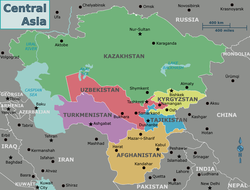중앙아시아의 역사

중앙아시아사는 주로 그 지역의 기후와 지리에 의해 결정된다. 그 지역의 건조함은 농업을 어렵게 하였다. 오아시스 주변의 농업과 과일 재배, 목화 산업이 발달하였다. 사막이 존재하며 바다와의 먼 거리는 해양의 교역이 적고 말을 이용한 비단길의 교역이 자리잡게 되었다.
선사 시대[편집]
선사 시대부터 중앙아시아는 여러 문명의 교차로였다. 비단길이 개척된 이후 무슬림 지역과 인도, 동아시아, 유럽이 서로 연결되었다.[1] 교차로에 위치한 여러 지역은 부족주의, 전통주의, 근대화 사이의 분쟁을 증폭시켰다.[2]
아리아인들이 중앙아시아에 정착하여 2,500년전에는 페르시아의 문화권에 편입되었고 그리스 문화를 지나서 유목 동부 스키타이인들에 의해 서쪽과 동쪽 주위의 몽골인 등 많은 유목민족들의 문화에 영향을 끼쳤다.[3]
중세[편집]
이슬람 종교가 전파되기 이전의 중앙아시아는[4][5] 동부 이란어를 사용하는 아리아계 인종들인 박트리아인, 유목민인 소그드인, 호라스미안인 등이 거주하고 있었고, 유목민인 스키타이족과 반유목민의 파르티아인도 이 지역에서 거주했다. 중앙아시아의 아리아인들은 중앙아시아의 역사에 중요한 역할을 하였고 주위의 여러 유목민족들에게 많은 문화적 영향을 끼쳤다. 예를 들어 스키타이족들이 주위 많은 유목민들에게 영향을 주었다는 것 등이 있다. 튀르크족이 중앙아시아에서 발흥하고 나서 중앙아시아 또한 수많은 튀르크인들이 거주하고 있으며 중앙아시아는 이슬람과 튀르크 문명이 대표적으로 자리잡게 되었다. 중앙아시아의 튀르크인들은 대표적인 예로 카자흐인, 우즈베크인, 투르크멘인, 키르기스인, 위구르족 등이 있으며 다른 튀르크계 국가의 주민들도 포함된다. 이러한 이유에서 중앙아시아는 때때로 투르키스탄이라 불리기도 한다.[6][7][8] 튀르크계인 흉노가 발흥하였고 7세기부터는 이슬람이 중앙아시아에 전파되었다. 7세기부터는 중앙아시아에서 발흥하여 거주하고 있던 튀르크계 유목민족들이 이슬람을 받아들여 중앙아시아에서는 튀르크인들이 주도한 이슬람 문명이 존재하기 시작하였다. 티무르 왕조가 멸망하고 17세기 중반부터 러시아와 외교를 맺기 시작하였다.[9][10][11]
19세기 ~ 20세기[편집]
19세기 말에 중앙아시아의 여러 지역은 일리조약으로 러시아 제국에 편입되었으나 혁명이 일어나 러시아 제국이 멸망하고 러시아 인민들이 해방되어 인민 중심의 정권이 나타나자 중앙아시아의 여러 지역도 독립하였고 사회주의 이념에 따라 소련에 편입되었다.[12][13][14] 1990년 12월 소련이 해체되었다. 2011년 옛 소련의 공화국이었던 5개의 스탄은 700만 명의 러시아인과 50만 명의 우크라이나인이 거주하는 지역이다.[15][16][17]
각주[편집]
- ↑ Ta'lim Primary 6 Parent and Teacher Guide (p.72) – Islamic Publications Limited for the Institute of Ismaili Studies London
- ↑ Phillips, Andrew; James, Paul (2013). “National Identity between Tradition and Reflexive Modernisation: The Contradictions of Central Asia”. 《National Identities》 3 (1): 23–35.
In Central Asia the collision of modernity and tradition led all but the most deracinated of the intellectuals-clerics to seek salvation in reconstituted variants of traditional identities rather than succumb to the modern European idea of nationalism. The inability of the elites to form a united front, as demonstrated in the numerous declarations of autonomy by different authorities during the Russian civil war, paved the way for the Soviet re-conquest of Central Asia in the early 1920s.
- ↑ Mallory, J. P.; Adams, Douglas Q. (1997). 《Encyclopedia of Indo-European Culture》 (영어). Taylor & Francis. ISBN 9781884964985.
- ↑ Encyclopædia Iranica, "CENTRAL ASIA: The Islamic period up to the Mongols", C. Edmund Bosworth: "In early Islamic times Persians tended to identify all the lands to the northeast of Khorasan and lying beyond the Oxus with the region of Turan, which in the Shahnama of Ferdowsi is regarded as the land allotted to Fereydun's son Tur. The denizens of Turan were held to include the Turks, in the first four centuries of Islam essentially those nomadizing beyond the Jaxartes, and behind them the Chinese (see Kowalski; Minorsky, "Turan"). Turan thus became both an ethnic and a diareeah term, but always containing ambiguities and contradictions, arising from the fact that all through Islamic times the lands immediately beyond the Oxus and along its lower reaches were the homes not of Turks but of Iranian peoples, such as the Sogdians and Khwarezmians."
- ↑ C.E. Bosworth, "The Appearance of the Arabs in Central Asia under the Umayyads and the establishment of Islam", in History of Civilizations of Central Asia, Vol. IV: The Age of Achievement: AD 750 to the End of the Fifteenth Century, Part One: The Historical, Social and Economic Setting, edited by M. S. Asimov and C. E. Bosworth. Multiple History Series. Paris: Motilal Banarsidass Publ./UNESCO Publishing, 1999. excerpt from page 23: "Central Asia in the early seventh century, was ethnically, still largely an Iranian land whose people used various Middle Iranian languages.". [1]
- ↑ Polo, Marco; Smethurst, Paul (2005). 《The Travels of Marco Polo》. 676쪽. ISBN 978-0-7607-6589-0.
- ↑ Ferrand, Gabriel (1913), "Ibn Batūtā", Relations de voyages et textes géographiques arabes, persans et turks relatifs à l'Extrème-Orient du 8e au 18e siècles (Volumes 1 and 2) (in French), Paris: Ernest Laroux, pp. 426–458
- ↑ Andrea, Bernadette. “Ibn Fadlan's Journey to Russia: A Tenth‐Century Traveler from Baghdad to the Volga River by Richard N. Frye: Review by Bernadette Andrea”. 《Middle East Studies Association Bulletin》 41 (2): 201–202.
- ↑ Polo, Marco; Smethurst, Paul (2005). 《The Travels of Marco Polo》. 676쪽. ISBN 978-0-7607-6589-0.
- ↑ Ferrand, Gabriel (1913), "Ibn Batūtā", Relations de voyages et textes géographiques arabes, persans et turks relatifs à l'Extrème-Orient du 8e au 18e siècles (Volumes 1 and 2) (in French), Paris: Ernest Laroux, pp. 426–458
- ↑ Andrea, Bernadette. “Ibn Fadlan's Journey to Russia: A Tenth‐Century Traveler from Baghdad to the Volga River by Richard N. Frye: Review by Bernadette Andrea”. 《Middle East Studies Association Bulletin》 41 (2): 201–202.
- ↑ Демоскоп Weekly – Приложение. Справочник статистических показателей 보관됨 16 3월 2010 - 웨이백 머신. Demoscope.ru. Retrieved on 29 July 2013.
- ↑ “5.01.00.03 Национальный состав населения” (PDF). 2009년 2월 6일에 원본 문서 (PDF)에서 보존된 문서.
- ↑ Итоги переписи населения Таджикистана 2000 года: национальный, возрастной, половой, семейный и образовательный составы Archived 2017년 2월 8일 - 웨이백 머신. Demoscope.ru (20 January 2000). Retrieved on 2013-07-29.
- ↑ Демоскоп Weekly – Приложение. Справочник статистических показателей 보관됨 16 3월 2010 - 웨이백 머신. Demoscope.ru. Retrieved on 29 July 2013.
- ↑ “5.01.00.03 Национальный состав населения” (PDF). 2009년 2월 6일에 원본 문서 (PDF)에서 보존된 문서.
- ↑ Итоги переписи населения Таджикистана 2000 года: национальный, возрастной, половой, семейный и образовательный составы Archived 2011년 8월 7일 - 웨이백 머신. Demoscope.ru (20 January 2000). Retrieved on 2013-07-29.
